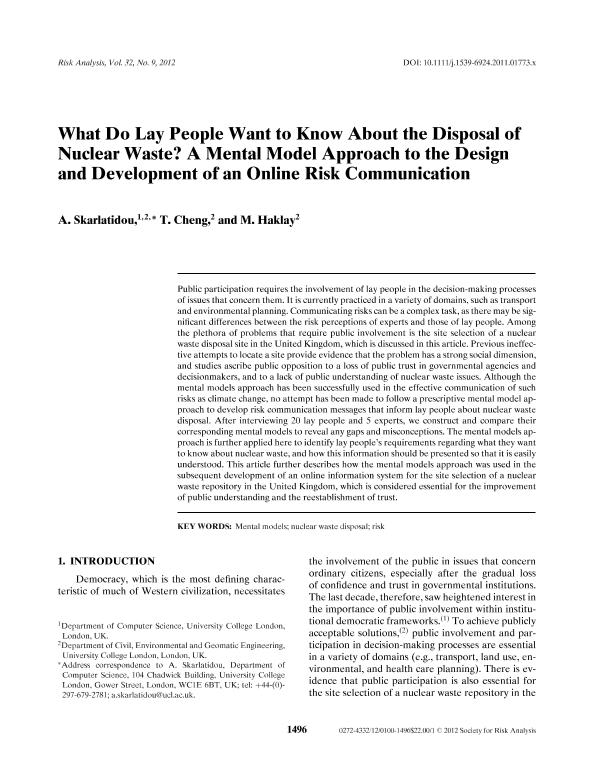What do lay people want to know about the disposal of nuclear waste? A mental model approach to the design and development of an online risk communication

Contenido multimedia no disponible por derechos de autor o por acceso restringido. Contacte con la institución para más información.
| Tag | 1 | 2 | Valor |
|---|---|---|---|
| LDR | 00000cab a2200000 4500 | ||
| 001 | MAP20120039902 | ||
| 003 | MAP | ||
| 005 | 20121011120057.0 | ||
| 008 | 120917e20120903esp|||p |0|||b|spa d | ||
| 040 | $aMAP$bspa$dMAP | ||
| 084 | $a7 | ||
| 100 | 1 | $0MAPA20120022584$aSkarlatidou, A. | |
| 245 | 1 | 0 | $aWhat do lay people want to know about the disposal of nuclear waste? A mental model approach to the design and development of an online risk communication$cA. Skarlatidou, T. Cheng, M. Haklay |
| 520 | $aPublic participation requires the involvement of lay people in the decision-making processes of issues that concern them. It is currently practiced in a variety of domains, such as transport and environmental planning. Communicating risks can be a complex task, as there may be significant differences between the risk perceptions of experts and those of lay people. Among the plethora of problems that require public involvement is the site selection of a nuclear waste disposal site in the United Kingdom, which is discussed in this article. Previous ineffective attempts to locate a site provide evidence that the problem has a strong social dimension, and studies ascribe public opposition to a loss of public trust in governmental agencies and decisionmakers, and to a lack of public understanding of nuclear waste issues. Although the mental models approach has been successfully used in the effective communication of such risks as climate change, no attempt has been made to follow a prescriptive mental model approach to develop risk communication messages that inform lay people about nuclear waste disposal. After interviewing 20 lay people and 5 experts, we construct and compare their corresponding mental models to reveal any gaps and misconceptions. The mental models approach is further applied here to identify lay people's requirements regarding what they want to know about nuclear waste, and how this information should be presented so that it is easily understood. This article further describes how the mental models approach was used in the subsequent development of an online information system for the site selection of a nuclear waste repository in the United Kingdom, which is considered essential for the improvement of public understanding and the reestablishment of trust. | ||
| 650 | 1 | $0MAPA20080591182$aGerencia de riesgos | |
| 650 | 1 | $0MAPA20080588434$aToma de decisiones | |
| 650 | 1 | $0MAPA20100020593$aResiduos nucleares | |
| 650 | 1 | $0MAPA20080610401$aEliminación de residuos | |
| 650 | 1 | $0MAPA20080609115$aTransporte de residuos | |
| 650 | 1 | $0MAPA20080602871$aPercepción del riesgo | |
| 650 | 1 | $0MAPA20080609788$aComunicación del riesgo | |
| 651 | 1 | $0MAPA20080638290$aReino Unido | |
| 773 | 0 | $wMAP20077000345$tRisk analysis : an international journal$dMcLean, Virginia : Society for Risk Analysis, 1987-2015$x0272-4332$g03/09/2012 Volumen 32 Número 9 - septiembre 2012 , p. 1496-1511 |

